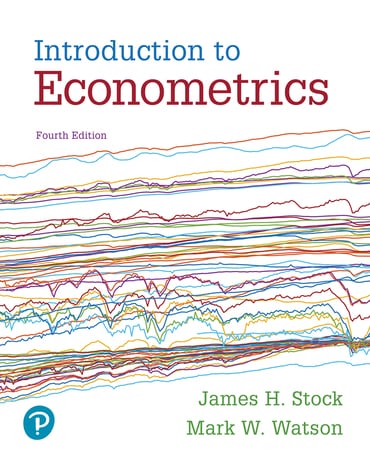
Introduction to Econometrics, 4th edition
Published by Pearson (November 6, 2018) © 2019
- James H. Stock |
- Mark W. Watson |
Switch content of the page by the Role togglethe content would be changed according to the role
Title overview
For intro econometrics courses.
Engaging applications bring the theory and practice of modern econometrics to life
Introduction to Econometrics connects modern theory and practice with engaging applications. The text focuses on currency, while adhering to the philosophy that applications should drive the theory, not the other way around. It incorporates real-world questions and data, and methods that are immediately relevant to the applications.
A new chapter dedicated to Big Data in the 4th Edition helps students learn about this growing and exciting area. This coverage and approach make the subject come alive for students and help them to become sophisticated consumers of econometrics.
Hallmark features of this title
- A modern treatment gives students enough econometric theory to understand the strengths and limitations of the tools, making the fit between theory and applications as tight as possible.
- The mathematics is kept at a level appropriate for an introductory course (algebra only).
- Students learn how to use the tools of regression analysis and assess the validity of empirical analyses through a threefold process.
- Students learn how to work with modern applications and very large or nonstandard data sets, including applications that predict consumer choices.
- Chapter introductions provide real-world context and a useful roadmap to help students navigate the material.
- Key Concept boxes and End-of-Chapter Summaries recap key ideas, helping students study more efficiently.
New and updated features of this title
- NEW: A new chapter 14 is dedicated to big data and machine learning methods that can help them have much lower out-of-sample prediction errors.
- NEW: Ch. 17 extends the many-predictor focus of Ch. 14 to time series data. Students learn how to forecast future values; an important skill to have as professionals in the field.
- NEW: Regression is now introduced with parallel treatment of prediction and causal inference. This highlights the different demands on how data can be collected (randomized vs. controlled variables).
- UPDATED: General Interest boxes provide students with interesting insight into related topics, while also highlighting real-world studies. Expanded discussions include the historical origins of instrumental variables regression (Ch.12).
- UPDATED: Review the Concepts questions and Exercises let students check their understanding. Empirical Exercises have them apply what they've learned to answer real-world empirical questions.
Key features
Features of MyLab Economics for the 4th Edition
- EXPANDED: The 4th Edition features more exercises covering more topics. This allows instructors greater flexibility in assigning auto-graded exercises that provide instant, personalized feedback to students.
Table of contents
PART I: INTRODUCTION AND REVIEW
- Economic Questions and Data
- Review of Probability
- Review of Statistics
PART II: FUNDAMENTALS OF REGRESSION ANALYSIS
- Linear Regression with One Regressor
- Regression with a Single Regressor: Hypothesis Tests and Confidence Intervals
- Linear Regression with Multiple Regressors
- Hypothesis Tests and Confidence Intervals in Multiple Regression
- Nonlinear Regression Functions
- Assessing Studies Based on Multiple Regression
PART III: FURTHER TOPICS IN REGRESSION ANALYSIS
- Regression with Panel Data
- Regression with a Binary Dependent Variable
- Instrumental Variables Regression
- Experiments and Quasi-Experiments
- Prediction with Many Regressors and Big Data
PART IV: REGRESSION ANALYSIS OF ECONOMIC TIME SERIES DATA
- Introduction to Time Series Regression and Forecasting
- Estimation of Dynamic Causal Effects
- Additional Topics in Time Series Regression
PART V: THE ECONOMIC THEORY OF REGRESSION ANALYSIS
- The Theory of Linear Regression with One Regressor
- The Theory of Multiple Regression
